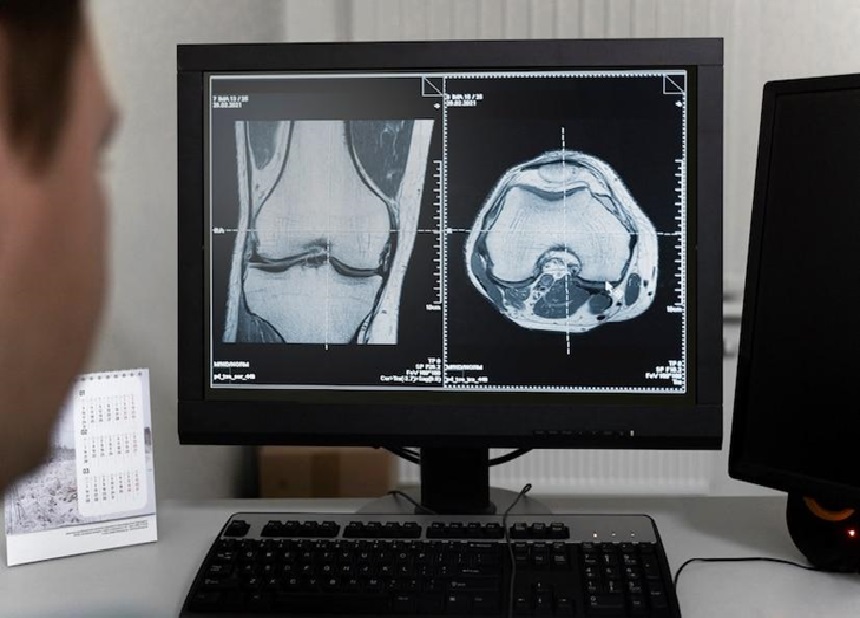If you’re experiencing knee pain, a CT scan may help diagnose the cause, such as fractures, ligament tears, or cartilage damage. During the procedure, you’ll lie on a table and be moved into a doughnut-shaped machine, where it will take multiple X-ray images of your knee. These images are then reconstructed to provide detailed cross-sectional views, helping your healthcare provider diagnose and plan treatment effectively. Understanding the process can ease any concerns and ensure a smooth experience.
What Is A CT Scan, And How Does It Work?
A CT scan combines multiple X-ray images from various angles to create detailed cross-sectional body views. This advanced imaging technique allows doctors to examine internal structures with exceptional clarity, such as bones, cartilage, and muscles. It is beneficial for diagnosing complex knee injuries like fractures, ligament tears, and degenerative changes, offering a comprehensive view of both hard and soft tissues. CT scans are favored for their speed and accuracy, providing more detailed information than traditional X-rays.
Why CT Scans Are Used For Diagnosing Knee Pain
CT scans are often recommended for knee pain as they provide detailed images of the knee joint, especially when other imaging methods like X-rays or MRIs don’t offer conclusive results. They are particularly effective in diagnosing bone-related issues, such as subtle fractures or complex bone injuries that may be missed on regular X-rays. CT scans also help visualize ligaments and cartilage, detecting conditions like meniscus tears or ligament sprains, which are common causes of knee pain and dysfunction. This detailed imaging allows healthcare providers to develop accurate treatment plans.
Preparation For A Knee CT Scan

Preparing for a knee CT scan involves following specific instructions from Tellica Imaging’s healthcare team. These instructions may include fasting for several hours before the procedure to minimize the risk of nausea, mainly if contrast dye is used. Be sure to inform your healthcare provider about any medical conditions or medications you are taking, as adjustments may be necessary.
Notifying the medical staff of any allergies, particularly to iodine-based contrast materials commonly used to enhance CT images, is also essential. If you have a history of kidney problems, your healthcare provider may perform blood tests to assess kidney function before administering the contrast dye, ensuring your safety during the scan.
What To Expect During A Knee CT Scan Procedure
When you arrive for your knee CT scan, you’ll check in and complete any necessary paperwork. A technologist will guide you to the scanning room, where you may need to change into a hospital gown and remove any metal objects, such as jewelry or belts, which can interfere with the scan.
Depending on the examined area, you will lie on your back or side of the CT scan table. The table slides into the center of the large, doughnut-shaped scanner. Staying as still as possible during the scan is essential for clear images.
The process is usually quick, often taking just a few minutes. You may hear a whirring sound as the machine rotates. If contrast dye is used, you may feel a warm sensation as it’s injected, which is normal and typically passes quickly. The technologist will monitor you and be available to address any concerns.
Safety And Risks Associated With Knee CT Scans
CT scans are generally safe, but there are some risks. The main concern is exposure to ionizing radiation, though the dose is typically low. Repeated scans should be considered carefully.
If you’re pregnant or might become pregnant, inform the staff, as radiation can harm a fetus, and alternative imaging may be needed. For those with kidney problems, precautions may be necessary when using contrast dye.
Allergic reactions to the dye are rare but can include itching, rash, or difficulty breathing. Inform your provider about previous responses, and report any issues during or after the scan.
Interpreting The Results Of A Knee CT Scan
After your knee CT scan, a radiologist will review the images and prepare a report for your healthcare provider. The scan can identify conditions such as fractures, joint effusions, bone spurs, arthritis, or tumors. Based on the findings, your knee specialist will recommend treatment options, including physical therapy, medication, or surgery. If you have any questions about the results, a knee specialist can help clarify them and guide you through the next steps in your treatment plan.
Alternative Imaging Methods For Diagnosing Knee Pain
While CT scans effectively diagnose knee pain, alternatives like MRI, ultrasound, and X-rays can provide valuable insights. MRIs use magnets and radio waves to produce detailed images of soft tissues, making them ideal for assessing ligament, meniscus, and cartilage injuries. Using sound waves, ultrasound is non-invasive and often used to evaluate soft tissue structures, guide injections, or assess swelling. X-rays are essential for diagnosing bone-related issues like fractures and osteoarthritis but have limitations in visualizing soft tissues. Your healthcare provider will choose the most appropriate imaging method based on your symptoms and medical history.
Tips For A Successful Knee CT Scan Experience
To ensure a smooth knee CT scan, follow these tips:
- Communicate openly with your healthcare provider about any concerns, allergies, or medical conditions.
- Arrive early to complete paperwork and relax before the scan.
- If you experience anxiety, practice relaxation techniques like deep breathing.
- Don’t hesitate to ask questions during the procedure—technologists are there to help.
Being prepared and informed can improve your comfort and ensure the best results from your knee CT scan.
Conclusion: The Importance Of CT Scans In Diagnosing Knee Pain
In conclusion, CT scans are essential for diagnosing knee pain, offering detailed images that help identify underlying conditions and injuries. Understanding the procedure can ease anxiety and ensure a smooth experience. Their ability to visualize bone and soft tissue makes CT scans invaluable for accurate diagnosis and treatment planning. As imaging technology evolves, CT scans will play a vital role in diagnosing knee issues, empowering patients to actively engage in their healthcare for better outcomes and improved quality of life.


